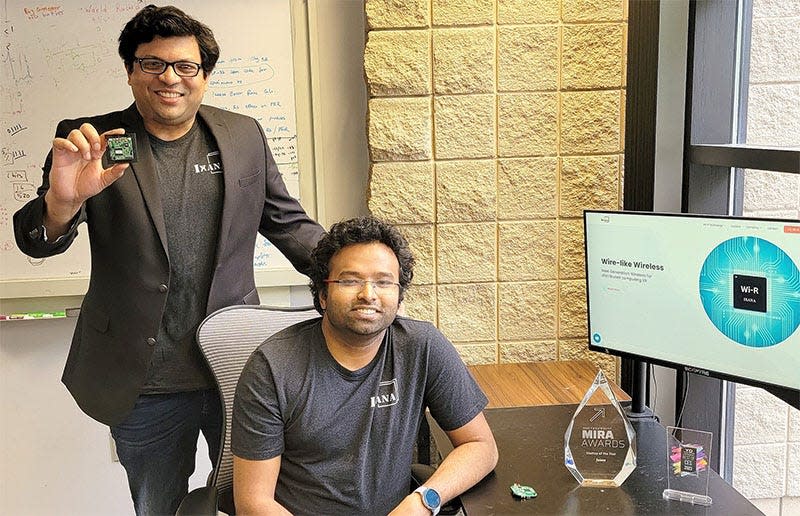Purdue Ventures invests $250,000 into wearable technology company
WEST LAFAYETTE, Ind. − Purdue Ventures has invested in Ixana, a wearable smart devices company that communicates with touch.
According to Ixana's website, the fact that human-computer interaction (HCI) is primarily done by looking at a six inch smart phone screen has "bothered Ixana's co-founders for more than a decade."
"They have worked independently as well as together to make HCI faster, more effective, and more efficient," the Ixana website states. "Ixana's founder and CTO, Shreyas, had the insight that distributed computing could transform HCI and high communication energy is the bottleneck to it. Realizing this, Shreyas and his research team invented Wi-R, an orders of magnitude energy-efficient and secure communication with transformative impact on HCI."

According to a release from the univeristy, Purdue Ventures' investment is part of a larger $3 million seed funding round for Ixana. Other companies that are a part of this backing include EvoNexus, Hack VC, Paradigm Shift Capital, Samsung Next and Uncorrelated Ventures.
The technology for the Wi-R silicon ship is based on "patented, published, peer-reviewed research" conducted by Shreyas Sen, the Elmore Associate Professor of Electrical and Computer Engineering in Purdue University’s Elmore Family School of Electrical and Computer Engineering and director of Purdue’s Center for Internet of Bodies, according to the release.
Sen stated that Wi-R "wire-like wireless" technology developed by Ixana has great potential to transform how wearable devices communicate with each other.
“The technology utilizes the conductive properties of the human body to guide tiny amounts of Electro-Quasistatic, or EQS, fields around the person,” Sen said in the release. “This allows high-speed broadband communication among on-body devices to securely communicate at a fraction of the energy cost compared to conventional wireless communication technologies. This allows wearables to use computing in smartphones without affecting battery power or latency.”
Sen went on to say that the human body "hurts" traditional wireless communications by absorbing radiofrequency signals.
“Radio was not designed to communicate around humans because of the high water content in our bodies,” Sen said in the release. “On the other hand, the human body helps EQS fields, making communication efficient.”
Purdue stated that the end-users of Ixana's technology are everyday consumers of personal electronic devices, like smartphones, smartwatches and other on-body devices.
“Today, every wearable device has its own CPU and communicates only when required because wireless is inefficient,” Sen said in the release. “Wi-R provides a virtually free ‘wire’ that enables efficient distributed computing on the body; all wearables can piggyback off the computing in the smartphone or another body-worn hub without a significant battery or latency hit. This means every wearable device can have access to real-time AI.
“Wi-R reimagines the architecture of wearable computing from standalone devices on the body to a tightly coupled computer-communication network connected by the body itself to enable longer-lasting, more secure devices while making the network more intelligent. In the process, it helps increase the adoption of wearables in the coming decades.”
Ixana co-founder and CEO Angik Sarkar stated that this technology will help AI become a larger part of people's everyday lives.
“The challenge is we largely interact with AI when we look at a screen or through voice prompts,” Sarkar said in the release. “Ixana's long-term goal is to enable our brain to interact with AI in real-time, all day long, while being in our physical world.”
Sarkar provided comment on how Purdue Ventures' investment will impact Ixana.
“Ixana’s North Star is to make Wi-R ubiquitous in devices such as smartphones, smartwatches and AR/VR headsets,” Sarkar said in the release. “Purdue Ventures' investment moves Ixana closer to that goal. Further, the backing of Purdue Ventures helped leverage more investors to invest in Ixana. Being associated with Purdue University and Purdue Ventures means more partners and investors believe in the technology.”
Riley Gibb, associate director of Purdue Ventures, stated in the release that Ixana’s strong connections to Purdue research is a key qualifier for investment.
“We also recognize Ixana has taken a technological lead by creating the world’s first high-speed Wi-R silicon chip,” Gibb said in the release. “This innovation and its multiple applications will have an impact upon the adoption of wearable technology.”
This article originally appeared on Lafayette Journal & Courier: Purdue plays an important role in wearable smart devices company

